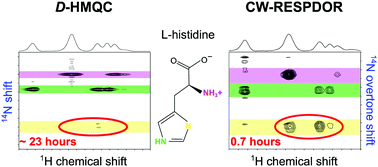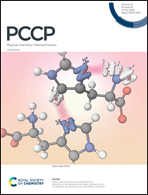Detection of remote proton–nitrogen correlations by 1H-detected 14N overtone solid-state NMR at fast MAS†
Abstract
Detecting proton and nitrogen correlations in solid-state nuclear magnetic resonance (NMR) is important for the structural determination of biological and chemical systems. Recent advances in proton detection-based approaches under fast magic-angle spinning have facilitated the detection of 1H–14N correlations by solid-state NMR. However, observing remote 1H–14N correlations by these approaches is still a challenge, especially for 14N sites having large quadrupolar couplings. To address this issue, we introduce the 1H–14N overtone continuous wave rotational-echo saturation-pulse double-resonance (1H–14N OT CW-RESPDOR) sequence. Unlike regular 2D correlation experiments where the indirect dimension is recorded in the time domain, the 1H–14N OT CW-RESPDOR experiment is directly observed in the frequency domain. A set of 1H–14N OT CW-RESPDOR filtered 1H spectra is recorded at varying 14N OT frequencies. Thanks to the selective nature of the 14N OT pulse, the filtered 1H spectra appear only if the 14N OT frequency hits the positions of the 14N OT central band or one of the spinning sidebands. This set of filtered 1H spectra represents a 2D 1H–14N OT correlation map. We have also investigated the optimizable parameters for CW-RESPDOR and figured out that these parameters are not strictly needed for our working magnetic field of 14.1 T. Hence, the experiment is easy to set up and requires almost no optimization. We have demonstrated the experimental feasibility of 1H–14N OT CW-RESPDOR on monoclinic L-histidine and L-alanyl L-alanine. The remote 1H–14N correlations have been efficiently detected, no matter how large the 14N quadrupolar interaction is, and agree with the crystal structures. In addition, based on the remote 1H–14N correlations from the non-protonated 14N site of L-histidine, we can unambiguously distinguish the orthorhombic and monoclinic forms.

- This article is part of the themed collection: 2022 PCCP HOT Articles


 Please wait while we load your content...
Please wait while we load your content...
